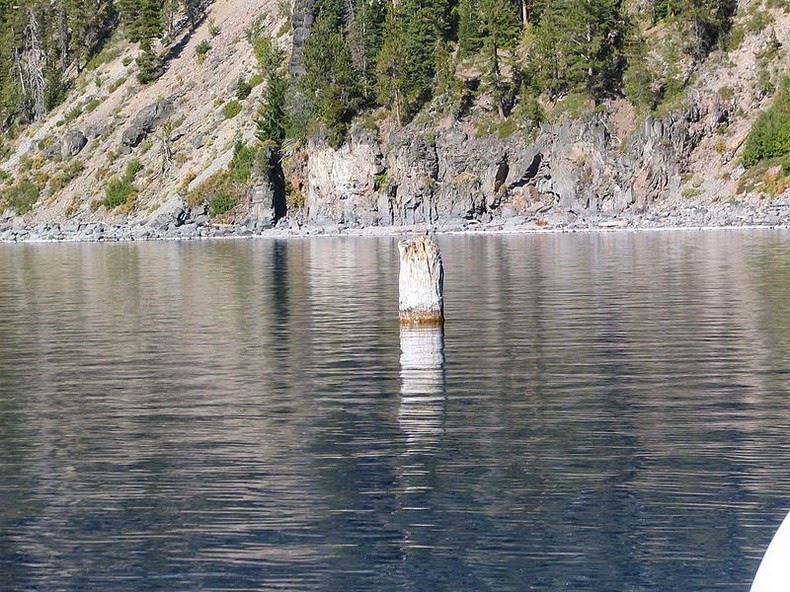In 1886, when geologist Joseph S. Diller was making the first geological study of Oregon’s Crater Lake, in the US, he noticed a tree stump completely untethered and moving about the lake as dictated by the wind and waves. Six years later, Diller published his findings in which he briefly described seeing the stump. This became the first written record of what eventually came to be known as the Old Man of the Lake. The 30 foot long ancient hemlock is still there, floating and bobbing, absolutely vertically, in the waters for more than 100 years. At the waterline the stump is about 2 feet in diameter and stands approximately 4 feet above the water. Its surface has been bleached white by many years of sun, and while the exposed end of the floating tree is splintered and worn, it is wide and buoyant enough to support a person's weight.
At first Diller thought the tree was rooted to the bottom and might constitute evidence that Crater Lake’s surface had risen over time. Later, Diller established that the tree was mobile by tying bailing wire to the exposed portion and pulling it a short distance. Over the years, the lake became a minor tourist attraction and the Old Man became a celebrity.
Why the Old Man floats so serenely, and has not become completely waterlogged and sank, or rotted, remains something of a mystery. The generally accepted theory is that the tree fell into the lake, presumably carried there by a landslide, taking along sufficient rocks trapped among its roots, to weigh it down and set it bobbing. Over time, the roots decayed and the rocks tumbled into the depths, but by then the trunk had become waterlogged, and the weight of that water kept it vertical. Whereas the four feet above the water dried out in the sun, and gave the Old Man just sufficient buoyancy to remain afloat. The cold water prevented the wood from rotting.
An outstanding feature of the Old Man is that it travels extensively throughout the lake. In 1938, park naturalist John Doerr spent three months tracking its travel patterns, and found that within that period, the tree moved 62 miles, and on one one particularly windy day, it traveled 3.8 miles.
Soon a legend rose that the Old Man controlled the weather. In 1988, during a submarine expedition of the lake, scientists tied him up near Wizard Island to avoid the tree bumping into the submarine. The story goes that the moment they did, the sky grew dark, and a storm blew in. The skies miraculously cleared only when the Old Man was released.
A park ranger demonstrates the buoyancy of the Old Man of the Lake. Circa 1930.

Sources: Wikipedia / A Blast from the Past / NPCA


















"In 1986, when geologist Joseph S. Diller was making the first geological study of Oregon’s Crater Lake..."
ReplyDeleteJosph Diller died in 1928.
http://www.craterlakeinstitute.com/cultural-history/people/js-diller.htm
Diller passed away in 1928. So I suspect that the date of his study of the lake should have been in 1886 rather than 1986.
ReplyDeleteThat was a mistake. The date has been corrected now.
Delete